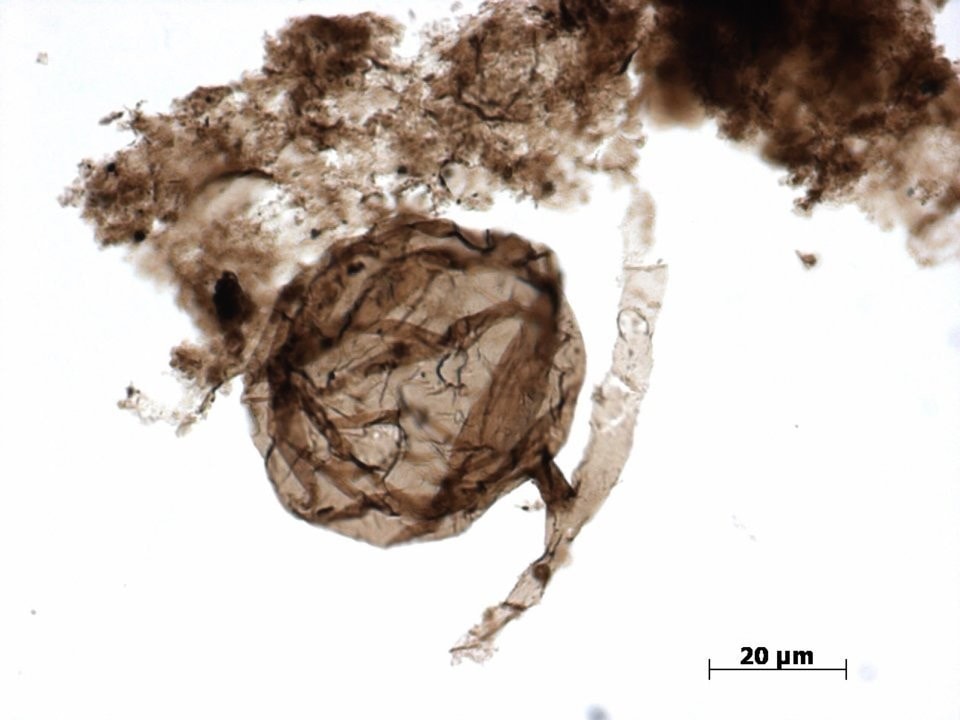This billion-year-old fungus could reveal how life migrated to land

This billion-year-old microscopic fossil fungus was unearthed in the North Territories of Canada. Image: Corentin Loron/University of Liege/Reuters
- Scientists discovered fossils of the oldest known fungus in the Canadian arctic. Fungi include mushrooms, yeasts, and molds.
- The billion-year-old fungus, called Ourasphaira giraldae, provides clues about how life may have evolved on land.
- In a new study, researchers discuss how the discovery of fungi like this one, which are more closely related to animals than plants, could indicate that animal ancestors were around 1 billion years ago.
When single-celled organisms first came into being out of the primordial ooze, they were content to meander the oceans. But at some point around 430 million years ago, plants and early animals left their watery cradle and journeyed landward, eventually colonizing the bare expanses of our planet's continents.
Scientists posit that plants were the first pioneers to make this trek from sea to land. Now, a billion-year-old fossil discovery shows that fungi may have led the way 500 million years earlier than we thought.
In a new study published in the journal Nature, researchers describe a fungus they discovered in a billion-year-old bed of shale rock in the Northern Territories area of Canada, which they named Ourasphaira giraldae. The ancient fungus is the ancestor of today's mushrooms, yeasts, and molds, and lived in at the mouth of a river between 890 million and 1.1 billion years ago. This is hundreds of millions of years before the advent of complex lifeforms.
The finding is "reshaping our vision of the world," lead author of the new study Corentin Loron told Business Insider.
The finding pushes back the known age of fungi
Though the term might bring to mind poisonous mushrooms or the mold on aging cheese, there are at least 120,000 types of fungi that do everything from treating pnemonia to breaking down food in cow's digestive tracts.

While scientists had a sense that fungi were some of the oldest known organisms on Earth, it was very difficult to confirm this theory because fungi rarely fossilize.
DNA analyses of the genes from existing fungi reveal that their common ancestor should be about a billion years old. But, until this discovery, scientists couldn't confirm that idea because the oldest fungi fossils ever found only dated back some 400 million years.
The Ourasphaira giraldae find, which is more than twice as old as the 400-million-year fossils, helps "confirm those theoretical models" about the older origins of fungi, according to Loron.
The fossils were first discovered in 2014 by one of the study's co-authors, Robert Rainbird, who then shared the discovery with Loron and their colleagues. It took many years of work to determine what these microscopic fossils actually were, however.
The scientists used electron microscopes to determine that the fossils were indeed fungi by identifying a substance called chitin in the specimen's cell walls. (Fungal cell walls, as well as insect and crustacean exoskeletons, contain chitin.)

What's more, the fossils had distinct spores connected to one another by tendril-like filaments called hyphae, which are characteristic of fungi.
Fungi pioneers may have laid the groundwork for plants to colonize land
Until now, researchers also thought that fungi and plants worked together to leave the ocean and take to the land as pioneering partners (fungi decompose organic matter and recycle that nutrients into the soil that plants then use to grow).
But the oldest known plants that colonized land are only 470 million years old. If the oldest fungi in the fossil record are 1 billion years old, that means fungi were around first — holding down the fort, as it were, solo for some 500 million years.
"We are far before the emerging of land plants," Loron said. "Nevertheless, researchers believe fungi may have preceded plant and may have been pioneer of land colonization."

It's possible, Loron told the New York Times, that Ourasphaira's 1-billion-year-old habitat provided "the toolbox for everything that's going on land afterward."
The first animals could've been around 1 billion years ago
The Ourasphaira discovery has a second implication too, the researchers said.
Fungi are the closest relatives to animals in the 'tree of life,' Loron told Business Insider. This means that, if fungi were already present around 1 billion years ago, animals were too, he added.

When Loron says animals, he doesn't mean the complex lifeforms of today. He's referring to the earliest microscopic members of the animal kingdom. "We're not talking about anything big like dinosaurs. It would be something very simple. Perhaps a sponge," Loron explained to The Guardian.
To Loron, this means that Ourasphaira's distant past, although very different from today's world (with continents at different places and a different atmosphere), "may have been much more modern than we thought."
Don't miss any update on this topic
Create a free account and access your personalized content collection with our latest publications and analyses.
License and Republishing
World Economic Forum articles may be republished in accordance with the Creative Commons Attribution-NonCommercial-NoDerivatives 4.0 International Public License, and in accordance with our Terms of Use.
The views expressed in this article are those of the author alone and not the World Economic Forum.
Stay up to date:
Future of the Environment
Forum Stories newsletter
Bringing you weekly curated insights and analysis on the global issues that matter.






